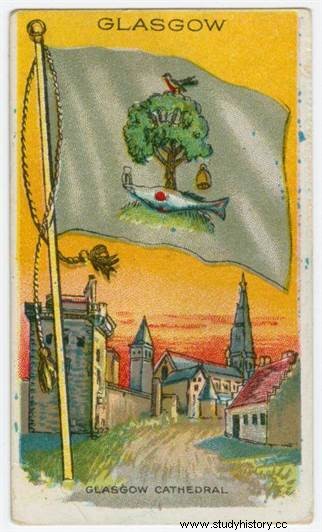 The City of Glasgow , located 50 km from the west coast of Scotland , is the heiress of a past with a thousand faces. Flagship of the British Empire during the great trade with the colonies in the 18th century, Glasgow is also one of the engines of the industrial revolution. It was in his university that a major event took place:the perfecting of the steam engine by James Watt. From the 1890s until the 1960s, the shipyards lined up along the Clyde, the river that runs through the city, produced the largest ocean liners in the world. But the economic boom echoes the growing distress of the working class, victim of overpopulation first, then of deindustrialization. Unemployment, poverty and crime punctuate the 1970s and 1980s. Glasgow manages to come out of the crisis from above. From the 1990s, an artistic and cultural frenzy seized the Scottish city, soon relayed by a new source of innovation:the digital economy.
The City of Glasgow , located 50 km from the west coast of Scotland , is the heiress of a past with a thousand faces. Flagship of the British Empire during the great trade with the colonies in the 18th century, Glasgow is also one of the engines of the industrial revolution. It was in his university that a major event took place:the perfecting of the steam engine by James Watt. From the 1890s until the 1960s, the shipyards lined up along the Clyde, the river that runs through the city, produced the largest ocean liners in the world. But the economic boom echoes the growing distress of the working class, victim of overpopulation first, then of deindustrialization. Unemployment, poverty and crime punctuate the 1970s and 1980s. Glasgow manages to come out of the crisis from above. From the 1990s, an artistic and cultural frenzy seized the Scottish city, soon relayed by a new source of innovation:the digital economy.
Medieval Glasgow:a provincial town without stories
Glasgow's history begins at the present site of Glasgow Cathedral, northeast of the city centre, when Saint Mungo founded a monastery there in the 6th century. The Christian missionary is the author of four miracles, no less, including a bird, a tree, a fish and a bell. These four elements have become the symbols of the Scottish city and Saint Mungo the patron saint of Glasgow.
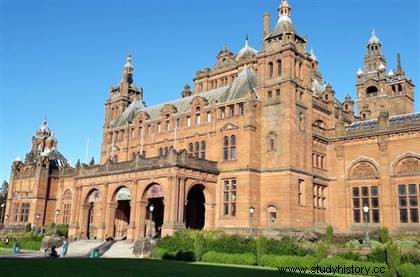 In the Middle Ages, the city therefore developed in the north around its religious center but also in the south on the banks of its river, the Clyde. A street still used today (High Street) connects the two population centers. The Clyde provides plenty of fish and the mild climate favors the production of fruit and vegetables. Glasgow prospers peacefully by trading with neighboring population centers as well as with the small city of Edinburgh.
In the Middle Ages, the city therefore developed in the north around its religious center but also in the south on the banks of its river, the Clyde. A street still used today (High Street) connects the two population centers. The Clyde provides plenty of fish and the mild climate favors the production of fruit and vegetables. Glasgow prospers peacefully by trading with neighboring population centers as well as with the small city of Edinburgh.
Of the medieval city, two emblematic monuments remain today:Glasgow Cathedral and Glasgow University.
A heritage to discover:the cathedral and the university
Glasgow Cathedral is the best known of the city's cathedrals. It is one of Scotland's major medieval buildings, a masterpiece of Gothic architecture. Its dark and intimidating exterior echoes an interior dominated by one of Britain's finest collections of stained glass. Leaning against the cathedral stretches an astonishing necropolis built on the hillside. The visitor is struck by its architectural originality. Along winding paths lined with trees, you come across Celtic crosses, pompous colonnaded mausoleums and even obelisks.
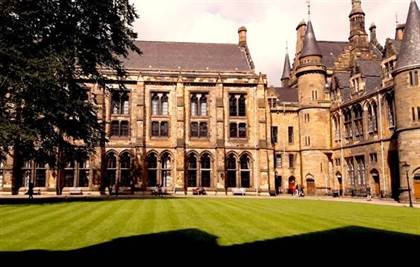 Glasgow University opened in 1451, to the west of the city. It is one of the oldest in Scotland and, more generally, in the Anglo-Saxon world. It has counted many famous figures in its ranks, including the economist Adam Smith, father of liberalism; inventor John Logie Baird, who created the first television in 1926; the engineer James Watt or, closer to us, the writer William Boyd. You can walk there along perfectly maintained lawned square courtyards. We walk along rows of dark stone buildings, topped with turrets and pierced with large Gothic-style windows. We walk through the cloister and stop for a few moments at the foot of the main building, the Gilbert Scott Building, and its 85-meter bell tower. Sir George Gilbert Scott, the architect of the building, is a figure of the "gothic revival" of the end of the Middle Ages.
Glasgow University opened in 1451, to the west of the city. It is one of the oldest in Scotland and, more generally, in the Anglo-Saxon world. It has counted many famous figures in its ranks, including the economist Adam Smith, father of liberalism; inventor John Logie Baird, who created the first television in 1926; the engineer James Watt or, closer to us, the writer William Boyd. You can walk there along perfectly maintained lawned square courtyards. We walk along rows of dark stone buildings, topped with turrets and pierced with large Gothic-style windows. We walk through the cloister and stop for a few moments at the foot of the main building, the Gilbert Scott Building, and its 85-meter bell tower. Sir George Gilbert Scott, the architect of the building, is a figure of the "gothic revival" of the end of the Middle Ages.
The Act of Union with England or the Glasgow take-off
Great trade with the British colonies
We are now entering the second phase of the history of Glasgow, which sees the Scottish city go in a few decades from the status of a provincial town to that of the second city of the Empire British. On May 1, 1707, Scots became British citizens after 700 years of independence. By the Act of Union signed with England, all powers are transferred to London. This is the birth of the United Kingdom. Globally, it is also that of Glasgow. The city indeed enjoys a strategic geographical location on the Atlantic coast and in front of it, the British Empire opens its doors wide.
Glaswegian traders seized the opportunity and quickly got rich from the tobacco trade with the colonies. After the American War of Independence in 1775, the sugar trade and especially the cotton trade took over. The great fortunes, such as Sir Thomas Lipton, and the governing bodies of Glasgow turn a blind eye to slavery. As elsewhere, all moral and ethical concerns are brushed aside. Result:Glasgow supplies the entire region with cotton. Spinning developed and, very quickly, turned the Scottish economy. The Industrial Revolution is coming…
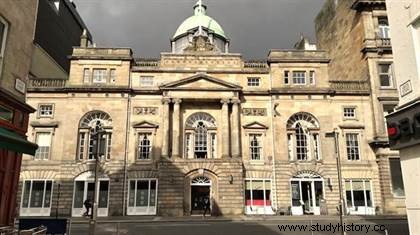 Merchant city, the "city of traders"
Merchant city, the "city of traders"
Wealthy merchants took up residence in the heart of the city and left the name "merchant city" to this district, which today visitors like to explore on foot. Opulent residences, warehouses and freshly renovated period offices are scattered along the streets, not far from the hyper-centre. Not to be missed:the Tobacco Exchange (Virginia Street), where the “Tobbaco Lords” negotiated sugar and tobacco, as well as the Trades Hall (Glassford Street), which housed the merchants' guild.
The industrial and working-class town
To the economic and artistic boom...
 From the end of the 18th century, Glasgow positioned itself as a major center of the emerging industrial revolution. The latter is largely the result of the mechanization of spinning mills. In this respect, the improvement of the steam engine by James Watt, who works at the University of Glasgow, marks a decisive turning point. The energy produced by the steam engine increases productivity tenfold. Spinning mills see their production jump and, soon, all industrial sectors follow. The context here is favourable. Glasgow indeed has a renowned university, where scientists and engineers acquire an excellent level. In addition, they work hand in hand with investors. Very often, moreover, entrepreneurs have a very good technical and scientific background. Result:innovations multiply and stimulate production. Iron and steel and heavy industry soon occupied a major place in the Glaswegian economy, and this until the 1960s. Clyde are the first in the world.
From the end of the 18th century, Glasgow positioned itself as a major center of the emerging industrial revolution. The latter is largely the result of the mechanization of spinning mills. In this respect, the improvement of the steam engine by James Watt, who works at the University of Glasgow, marks a decisive turning point. The energy produced by the steam engine increases productivity tenfold. Spinning mills see their production jump and, soon, all industrial sectors follow. The context here is favourable. Glasgow indeed has a renowned university, where scientists and engineers acquire an excellent level. In addition, they work hand in hand with investors. Very often, moreover, entrepreneurs have a very good technical and scientific background. Result:innovations multiply and stimulate production. Iron and steel and heavy industry soon occupied a major place in the Glaswegian economy, and this until the 1960s. Clyde are the first in the world.
Since the beginning of the 18th century, the city has never stopped getting richer, and it shows! The west and center of Glasgow are adorned with elegant neo-classical or Victorian-style "mansions", while the heart of the city shines thanks to its monumental public buildings financed by the new industrial magnates. Thus on George Square, the main square of Glasgow, the visitor can admire imposing Georgian monuments, such as the City Chambers (the town hall). In the West End, the Kelvingrove Art Gallery and Museum deploys its exotic architecture, influenced by the cathedral of Santiago de Compostela according to some.
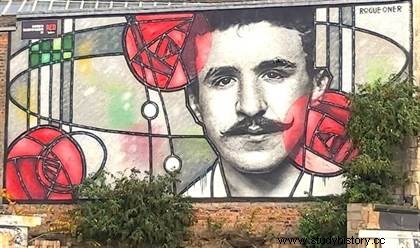 Art Nouveau has also left an indelible mark on the history of the Scottish city, both in the external architecture than in the interiors. At the turn of the 19th and 20th centuries, Charles Rennie Mackintosh and the artists of the “Glasgow Style” revolutionized architecture and design. Mackintosh is one of the best representatives of Art Nouveau on a European scale. The artist dusts off traditional styles. Place for functional interiors, austerity and stylized decorations inspired by nature, as evidenced by the House for an Art Lover, in the south of the city, or even exquisite tea rooms which today delight tourists and Glaswegian 'good society'.
Art Nouveau has also left an indelible mark on the history of the Scottish city, both in the external architecture than in the interiors. At the turn of the 19th and 20th centuries, Charles Rennie Mackintosh and the artists of the “Glasgow Style” revolutionized architecture and design. Mackintosh is one of the best representatives of Art Nouveau on a European scale. The artist dusts off traditional styles. Place for functional interiors, austerity and stylized decorations inspired by nature, as evidenced by the House for an Art Lover, in the south of the city, or even exquisite tea rooms which today delight tourists and Glaswegian 'good society'.
… responds to social misery
The contrast is stark. The glitzy facades of the west and center, the delicate Art Nouveau buildings respond to the miles of slums that cover the banks of the Clyde and the east of the city. At the beginning of the 20th century, Glasgow was overpopulated:
• in 1724, the city had between 15,000 and 20,000 inhabitants;
• in 1800:77,000;
• in 1850:250,000;
• in 1880:587,000 (6th largest city in the world);
• in 1912:1 million.
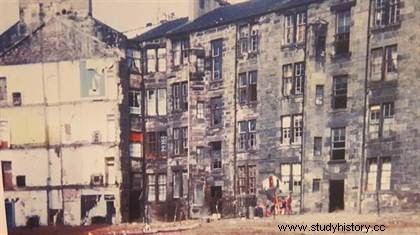 To fuel its economy, Glasgow very early captured a massive and growing flow of people from outside the city , in particular the Scots driven out of the highlands during the Highlands Clearances (forced eviction of the peasants) and the Irish fleeing the famine. Quickly, the city no longer manages to absorb these waves of labour. The workers pile into unsanitary tenements, these 2 to 4-storey buildings in red or ocher sandstone which have left their mark on the urban landscape. Families are accommodated in 2 rooms, “room and kitchen” (bedroom and kitchen) or in “single-end”, that is a kitchen with a recess housing one or more beds. Up to eight people can occupy a single-end. Epidemics are raging. In 1832, 3,000 people died of cholera. Gone are the days when the London writer Daniel Defoe could say:“Glasgow is one of the cleanest, most beautiful and best-built cities in Britain”! It was in 1724.
To fuel its economy, Glasgow very early captured a massive and growing flow of people from outside the city , in particular the Scots driven out of the highlands during the Highlands Clearances (forced eviction of the peasants) and the Irish fleeing the famine. Quickly, the city no longer manages to absorb these waves of labour. The workers pile into unsanitary tenements, these 2 to 4-storey buildings in red or ocher sandstone which have left their mark on the urban landscape. Families are accommodated in 2 rooms, “room and kitchen” (bedroom and kitchen) or in “single-end”, that is a kitchen with a recess housing one or more beds. Up to eight people can occupy a single-end. Epidemics are raging. In 1832, 3,000 people died of cholera. Gone are the days when the London writer Daniel Defoe could say:“Glasgow is one of the cleanest, most beautiful and best-built cities in Britain”! It was in 1724.
Decade after decade, no measure seems to eradicate the serious problem of workers' housing, until a radical decision has been taken. In the 1960s, the infamous “slums clearances” began, which can be translated as “slum cleaning”. The authorities razed entire streets and relocated the workers in the brand new high-rises, its sometimes 30-storey buildings that the municipality had built in outlying districts.
Deindustrialization and renewal
The end of the shipyards
There is a date to remember in the history of the Clyde shipyards, marking both their peak and the start of an inevitable decline… It is t is September 20, 1967, which will remain a day engraved in the hearts of Glaswegians, in particular of the 4,000 workers who participated in the construction of the “Queen-Elizabeth-II”. The queen is there, she greets the 30,000 people who came to attend its launch. It is she who baptizes the transatlantic, a little jewel of technology 300 m long and with a capacity of nearly 2,000 passengers. There is pride in the ranks... Doesn't the ad say:"The only thing the QE2 has in common with the other boats is that it floats". The "Queen-Elizabeth-II" was at that time the only merchant ship to carry a computer to facilitate navigation.
The 4,000 workers are certainly unaware that the launch of the liner marks the end of their reign. The "Queen-Elizabeth-II" is the last transatlantic built on the banks of the Clyde. Undermined by competition from Germany and Japan and too high production costs, the Glasgow shipyards declined. Today, there is almost nothing left:only the Finnieston Crane raises its black mass. This was used to hoist the locomotives onto the boats. More than just the shipyards, it is actually the entire industry of the region that is entering a phase of slow agony. In the 1970s and 1980s, unemployment, poverty, alcoholism and crime soared. Glasgow is bleak:dismal.
Renewal through culture and innovation
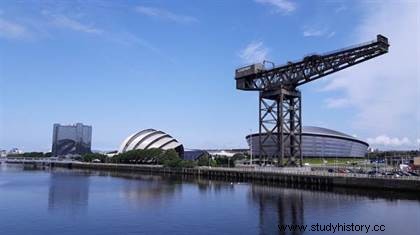 In 1990, Glasgow was designated European City of Culture; in 1999, City of Architecture and Design of the United Kingdom. In 2008, it became a UNESCO City of Music. These two decades mark a new historical stage. The creative effervescence revives the city and wins over the economy. Activities are diversifying and Scotland's largest city is once again becoming a hotbed of innovation. If the shipyards have disappeared, the banks of the Clyde are now the field of expression of internationally renowned architects. Let us mention the Auditorium, in the shape of an armadillo, built by Norman Foster in 1997; the SSE Hydro next door (a 13,000-seat concert hall) or the Riverside Museum and its zigzag facade designed by Zaha Hadid.
In 1990, Glasgow was designated European City of Culture; in 1999, City of Architecture and Design of the United Kingdom. In 2008, it became a UNESCO City of Music. These two decades mark a new historical stage. The creative effervescence revives the city and wins over the economy. Activities are diversifying and Scotland's largest city is once again becoming a hotbed of innovation. If the shipyards have disappeared, the banks of the Clyde are now the field of expression of internationally renowned architects. Let us mention the Auditorium, in the shape of an armadillo, built by Norman Foster in 1997; the SSE Hydro next door (a 13,000-seat concert hall) or the Riverside Museum and its zigzag facade designed by Zaha Hadid.
photo 9
Today, Glasgow is one of the most attractive cities in the UK. It forms with Edinburgh the "Silicon Glen", a term derived from the "Silicon Valley" (Glen means "valley" in the Celtic language). This belt connecting the 2 cities indeed sees investments in the tech industry jump. Today, Glasgow is quite simply the UK's No. 1 destination in this sector.
What remains of these 1,500 years of history? It remains a city of more than 600,000 inhabitants steeped in contrasts. A joyful and dynamic city that nevertheless harbors real pockets of poverty; a modern, innovative city whose landscapes still testify, sometimes, to a tattered industrial past. Glasgow amazes, fascinates, questions. Knowing its history is the key to understanding its particularities, but also to falling in love with it.
Selected Bibliography
- Michael Fry, Glasgow, A History of the City, Head of Zeus Ltd, 2017
- Robin Ward, Exploring Glasgow, Birlinn Ltd, 2017
- Scotland, Travel Encyclopedias, Gallimard, 2016
